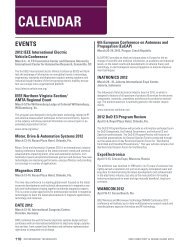2011 EMC Directory & Design Guide - Interference Technology
2011 EMC Directory & Design Guide - Interference Technology
2011 EMC Directory & Design Guide - Interference Technology
Create successful ePaper yourself
Turn your PDF publications into a flip-book with our unique Google optimized e-Paper software.
surge & transients<br />
A Risk A s s e s s m e n t f o r L i g h t ning Prote c t i o n S y s t e m<br />
Figure 2. U.S. lightning flash density map. (Map provided by Vaisala-GAI. Lightning data provided<br />
by the U.S. National Lightning Detection Network.)<br />
Surrounding Environment<br />
Structure surrounded by<br />
similar sized structures<br />
Structure surrounded by<br />
smaller sized structures<br />
Coefficient<br />
0.25<br />
0.5<br />
Isolated structure – level ground 1.0<br />
Isolated structure – hilltop 3.0<br />
Eqn. 2<br />
Where L is the length of the structure,<br />
W is the width of the structure,<br />
and H is the height of the structure.<br />
The surrounding environment of<br />
the facility has an integral affect on if<br />
and how lightning is going to strike a<br />
structure. Isolated structures located<br />
on a hilltop or mountain top are more<br />
vulnerable to lightning strikes than a<br />
structure located amongst similar sized<br />
structures. Determining the surrounding<br />
environment coefficient is done by<br />
choosing the appropriate values from<br />
Table 1.<br />
The final parameter needed to calculate<br />
the environmental factors associated<br />
with the facility is the lightning flash density. The<br />
lightning flash density is the amount of lightning flashes<br />
that occur per year per kilometer. This value can be obtained<br />
through a variety of sources. However, it is important to<br />
understand that averages can change over time. Therefore,<br />
one should obtain not only the average of an extended period,<br />
e.g. ten years, but also maximum and minimal values<br />
over a short period of time, e.g. three months. A lightning<br />
flash density map is shown in Figure 2.<br />
The tolerable risk of the facility (Nc) is determined by<br />
equation EQ3 and is dependent on the type of structure<br />
(C2), the contents within the structure (C3), the structure<br />
occupancy (C4), and the consequence of the loss of operations<br />
of the structure (C5).<br />
Table 1. Coefficients of surrounding environment (C1).<br />
Eqn. 3<br />
system requires the engineer to compare environmental<br />
factors (Nd) to the tolerable risk factors (Nc). Comparison<br />
is conducted by a ratio between the environmental factors<br />
and the tolerable risk. If the calculated ratio is 1.0 or greater,<br />
then a lightning protection system, which includes SPDs,<br />
is required. If the calculated ratio is less than 1.0, then a<br />
lightning protection system is not required.<br />
The environmental factors are calculated using the equation<br />
of Eqn. 1.<br />
Eqn. 1<br />
The environmental factors consist of the collective area<br />
of the facility (Ae), its surrounding environment (C1) and<br />
the lightning flash density (Ng) of the area. There are different<br />
equations to determine the collective area of the facility<br />
based on the type of structure: standard rectangular structure,<br />
rectangular structure with prominent riser, rectangular<br />
structure with small riser. The collective area for a standard<br />
rectangular structure is calculated using equation Eqn. 2.<br />
The type of structure is either metal with a non-metallic<br />
roof or metal with a metallic roof. Structures with other<br />
construction are not considered in this risk assessment. The<br />
coefficients for the type of structure are shown in Table 2.<br />
The content of the structure is the second parameter<br />
to be determined. The structure contents range from low<br />
value, nonflammable contents to those of exceptional value,<br />
irreplaceable cultural items. The coefficients associated with<br />
each parameter are denoted in Table 3.<br />
The occupancy of the structure is the third parameter<br />
that is determined. The definition of structure occupancies<br />
are: unoccupied; normally occupied; or difficult to evacuate.<br />
The coefficients associated with each parameter are<br />
denoted in Table 4.<br />
The consequence of an interruption of service as a result<br />
of lightning is the fourth parameter to be determined. The<br />
definitions are: continuity of service is not required, no<br />
environmental impact; the continuity of service is required,<br />
no environmental impact; or the there are consequences<br />
to the environment. The coefficients associated with each<br />
102 interference technology emc <strong>Directory</strong> & design guide <strong>2011</strong>


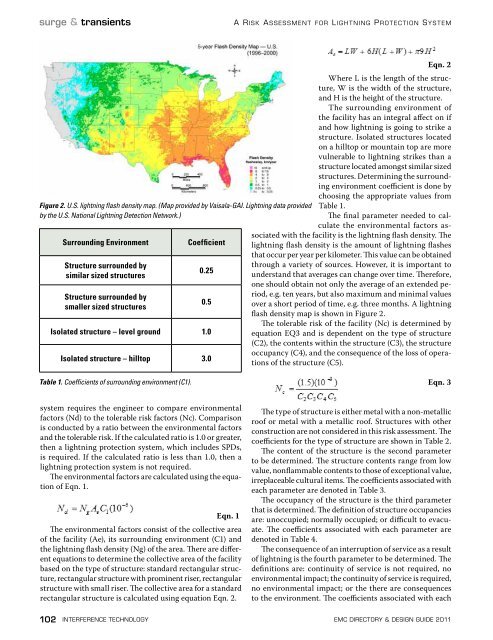

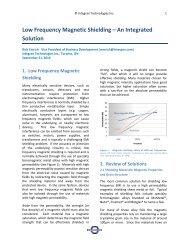

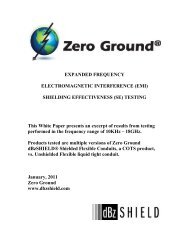
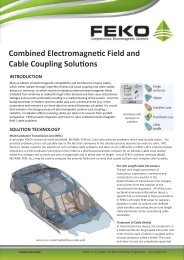

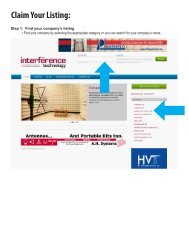

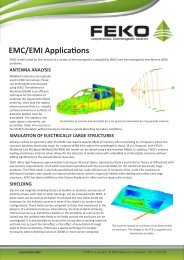
![[ thursday ] morning sessions 8:30 am-noon - Interference Technology](https://img.yumpu.com/23176841/1/190x247/-thursday-morning-sessions-830-am-noon-interference-technology.jpg?quality=85)
